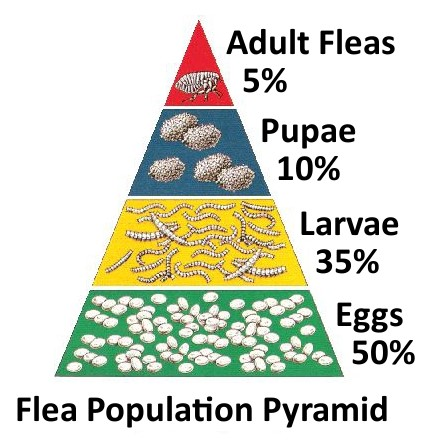Tails
Making pet parenting easy

What the Flea - Protect your home
This entry was posted on 2022-09-02.
When it comes to pet’s parasites, it is extremely important to not just treat the parasites on/in your pet, but also the environment!
To illustrate this, we will first discuss the problem of fleas in the environment. At the end of this article we will also mention some other parasites that can become a problem if the environment is not treated.
Fleas on pets
Fleas are more common in summer, but do not make the mistake of thinking you do not get any fleas in winter! In fact, winter is the time to get rid of all the remaining fleas – in order to prevent a big problem in summer!
To really understand the problem, one must understand the “flea-population-pyramid.”

The flea that you see on your dog is the adult flea – and she represents only 5% of the problem!! Pupae represents 10%, larvae 35% and eggs 50%! In other words: for every flea that you see, there are actually 20 fleas! And this is the root of the problem, because if you only treat the adult fleas (e.g. by putting drops on the neck or using flea collars or flea powder), you are literally only treating the tip of the iceberg. It is therefore also important to treat the environment to get rid of all the immature life stages.
One female flea can lay 50 eggs per day … for the 100 days of her life! As soon as the larvae turns into a pupae, that pupae can survive for 12 months before it develops into an adult flea – in other words: it is important to treat both your pets and environment against fleas throughout the year.
Treating the fleas on your pet:
1) Flea shampoo – it only kills the adult fleas and usually only for a day.
2) Dips – most dips works against ticks and mites, but not fleas.
3) Normal Flea collars – only kills adult fleas and are more effective inside the vacuum cleaner bag then on the dog!
4) Seresto® collars – it repels and kills ticks and kills fleas on cats and dogs and lasts for 8 months.
5) Flea powder – kills only the adult fleas and works for about 2-3 days.
6) Spot-on treatment (e.g. Bravecto®, Frontline®, Revolution®) – some products work for a month, other for 3 months. Some types only kills the adult fleas while others prevent the larvae from developing in the egg or the pupae from the larvae.
7) Tablets – There are 4 different flea and/or tick tablets. The first is Program® and it results in fleas lying eggs that are infertile. Therefore you prevent the next generation of fleas. The second tablet is Capstar® and it kills all adult fleas on the animal within 30 minutes. However, it only works for 24 hours. The third tablet is Nexgard® – it kills fleas and ticks on your dog and last for a month. The fourth tablet is Bravecto® – it kills fleas, ticks and mites on you dog and lasts for 3 months.
Treating the environment:
1) Vacuum daily – By vacuuming your house, you remove all adult fleas, eggs, larvae and pupae. Put a flea collar in the vacuum cleaner’s bag and empty the bag regularly.
2) Wash all bedding, clothes and furniture covers weekly at a temperature of 60°C.
3) Use insecticides (which kill all life stages) in your house and garden.
Other parasites that might lurk in your environment:
If you do not disinfect your home/environment, the following parasites can also be present and re-infect the pets (or in some cases the humans) living there:
• Roundworms: Roundworms are the most common intestinal parasite in dogs and cats. Roundworms in dogs can be identified as spaghetti-like shapes in the faeces or, in severe cases, in vomit. The worms can migrate throughout the body, but they live off food in the intestinal tract of their host. Eggs are shed by female worms in the stool, and ingestion of those eggs is how an animal becomes infected. Roundworms can be killed by most de-wormers, but repeat doses are usually necessary.
• Hookworms: Hookworms are relatively common parasites as well. Adult worms are very small and thin, often not noticed in the stool. The worms “hook” into the lining of the intestines and actually feed off the host’s blood. Eggs are shed by female worms in the stool, but the eggs quickly hatch to become larva. These larvae can infect other animals, including people, by being eaten or penetrating through bare skin.
• Whipworms: Whipworms are small, thin worms with an even thinner tail that looks like a whip. They dig their tail into the lining of the large intestine, causing irritation and diarrhea. Eggs are shed by female worms. These eggs are not shed all the time, so seeing them on tests can be difficult, and the eggs can live in the environment for months at a time.
• Tapeworms: Tapeworms are usually diagnosed by actually seeing little “rice-grain” segments around an animal’s rectum. Tapeworms live off food in the intestines. Pets get tapeworms by eating an intermediate host like a mouse or flea.
• Coccidia: Coccidia are microscopic organisms called protozoa that live in the lining of the gut and can cause diarrhea. They are shed as cysts and are ingested to re-infect animals.
• Giardia: Giardia are intestinal parasites that live in moist environments, especially ones where there is standing water. Giardia can cause vomiting and diarrhea. They are also shed as cysts into the environment and are ingested to re-infect animals. People can also be infected if they should ingest contaminated water or food.


